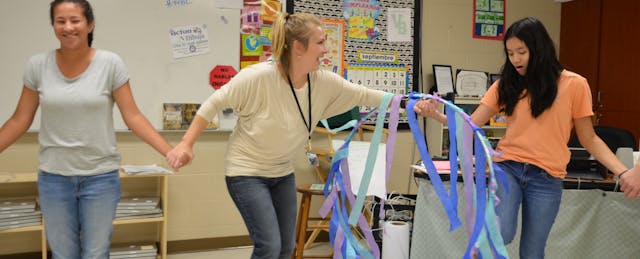Come with me and take a walk through my classroom.
As we enter the room, you’ll first notice that there are no desks, no tables, no chairs. It’s striking, isn’t it? You’ll see the students standing around chatting. Yes, they are speaking Spanish, but if you watch carefully, you will see the gestures they make and the body language they use to negotiate meaning and guide one another in the complicated dance that is speaking a second language.
Each word, every conversation, is focused on the students’ needs for information, and their own passions they bring to the classroom. After all, no child has—or even needs—the same set of vocabulary or structures to talk about herself, her life, or her family. Throughout the year, this language will grow and be used to tackle more and more complex situations that are based on the students’ lives and their needs for new words to describe the new situations. In my Spanish Language Acquisition course, this is what is meant by personalized learning.
If you stay awhile longer, you will be able to experience my Spanish for Heritage Learners classes. These students will open your mind to new possibilities for the world and for the future. Do you see how they interact? Do you see how happy and open they are with one another?
There are not many safe places for these students in the school, or even in the community. Yet in my classroom, or our “family” as we call it, they blossom. Unfortunately, our family has quite a challenge to overcome. For 10 or more years of school, my children have suffered the consequences of low expectations. Teachers who found them hard to reach and hard to teach, too often gave up or gave into the temptation of lowering the bar for these beautiful, capable students. Now, in our family, my students struggle with the newfound knowledge that someone loves them enough and believes in them enough to expect them to reach their full potential. They struggle with the space that is allowed for them to be themselves, choose their own outcomes, take risks, and make mistakes. In my Spanish for Heritage Learners course, even though sometimes it’s tough, this is personalized learning.
Knowing my students well, and giving them the room to incorporate their passions into their work, makes me the best teacher I can be for my students. It gives them an education that is authentic and truly useful in the context of real life. In my classroom, if learning isn’t personalized, then it isn’t worth much to me or to the world at all, much less to my students. At the center of my work, one question remains constant, “What is the purpose?”
The purpose, for me, is to give each student the skills to reach his or her full potential in life. The skills that one student needs are not the same as those that another will need. They certainly do not possess the same passions that will drive them down the same paths in life, so why should their learning be identical?
Teachers will ask, “How do I give useful skills to 150 different students every day?” It begins with student voice, is bolstered by high expectations, and ends with humans who can think critically about the world around them while working to lift up those around them.
We need to invest in our students’ individualities if we want them to invest in us. And if they can’t invest in us, they surely will not be invested in the community and the larger society. Flip that around, and you find a picture of teachers elevating the students’ passions by allowing them to control their learning, right down to the assessment.
If the overall goal is to foster in humans the ability to think critically about the world around them, then our classroom should be the laboratory for that concept. No matter the subject area, or the goals of our program, by allowing students the freedom to form their learning to their distinct needs and desires, then we are giving them the best gift possible in life.
The next time you find yourself trapped by the toil that is the noble profession of teaching, stop and ask yourself, “What is the purpose?” Hopefully, you, too, will find the answer within your students.


